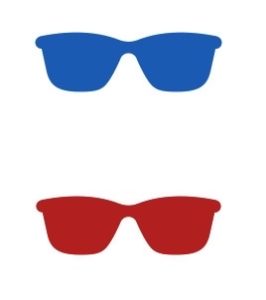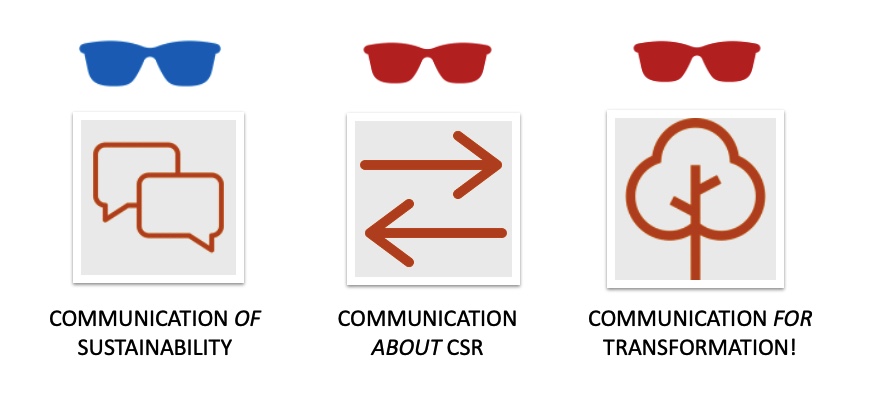III.1. CSR and Sustainability Communication
Franzisca Weder
The lady…
Leaving the bookshop, I stumbled over a newspaper that someone has dropped on the pathway. The headline was horrible:
"Global carbon dioxide emissions hit new highs"
I know, it’s happening. But it gives me shivers if I think about it. The changing climate, global hazards.
Today, climate change, environmental and ‘green’ or sustainability issues seem to be everywhere; the most prevalent ones are renewable vs. fossil energy sources, waste and pollution. Furthermore, the public is interested in water supply and the risk of scarcity or floods, food and land management, ecosystems and endangered species or bushfires, as well as public health issues – not to talk about a pandemic and possible effects on/or possibly being affected by the current human-nature-(non)relationship.
Organizations are at the focus of this book – and how (much) they communicate for sustainability to take responsibility in this multiple crisis scenario (see Introduction and part I). We have learned from looking at existing CSR communication research that corporations have made a massive effort to take responsibility in an environmental, social and economic dimension, to take on the responsibility that is allocated to them by the public or their stakeholders. Over the past decade, corporations have conceptualized themselves as “citizens” (Carroll, 1998), tried to maximize their business returns by taking ‘corporate social responsibility’ (Du, Bhattacharya & Sen, 2010). Consequently, they developed CSR concepts, strategies and performance to communicate about it (Aguinis and Glavas, 2012).
Today, CSR has become an undisputed – yet contested – concept of corporate conduct in a globalized business world (Rasche et al., 2017). Consequently, still the European Commission’s outline counts, stating that CSR is not a voluntary engagement anymore but a “corporate behavior which integrates social, environmental, ethical, consumer, and human rights concerns into their business strategy and operations” (European Commission, 2011, p. 6). From there, obligations and legal requirements to communicate and report about activities with which an organisation contributes to sustainable development (e.g. European Council, 2014; Gulenko, 2018) have increased which goes hand in hand with the institutionalization of frameworks to measure related activities (i.e. GRI)
However, CSR endeavors are sometimes driven by intrinsic ethical motives or the perception that sustainable development is a deeper process of ethical reflection within organizations and thus part of their culture, but much more often it is stimulated by the expectation of possible business returns that companies may reap from CSR initiatives, namely building trust and reputation, customer loyalty, brand equity as well as generating positive effects in employee recruitment. Organisations expect that “doing good” and the communication of the CSR activities will also lead to “doing better” through positive reactions of key stakeholder groups like consumers (Bhattacharya and Sen, 2004). Bringing in a communication perspective means impact orientation but by the same time includes the awareness that the communication needs to be ethical as well:
From a communication perspective, the principle of sustainability can guide the business case – it is not a business case itself. The principle of sustainability can guide CSR communication. Then, sustainability works as guiding principle to secure that CSR communication is impactful (see previous chapter).
So, after an era of institutionalization of mainly external CSR communication (1990-2020) we have reached a tipping point where current forms of CSR communication and practices are increasingly challenged, and we can see a reorientation of CSR communication from information to impact orientation and from communication about CSR (informational approach) to communicative responsibility (impact-oriented approach) following sustainability as a new normative framework – also for all forms of strategic and corporate communication (Weder et al., 2019), which will be further discussed in this third part of the book.
The lady…
The lady joined me on the pathway, staring at the newspaper and the frightening headline. She put her sunglasses on; suddenly she looked different, more distant. Apparently, she was still looking at me, because she asked me if I do understand what is meant by taking different perspectives on communication. Of course, I knew … however; what does it change, if we understand communication as mean to an end, as channel to be used to get connected with a certain group of people or if we think of communication as interaction, as core process of our society, as process of negotiation?
I kept on pondering: every conversation – like the one, I’m having with this lady – creates meaning, creates frames and a specific picture of the world. Not only big headlines like the one in the newspaper. Not only shared media articles on twitter.
“There is a difference”, she said, “between a birds-eye perspective, looking at the media and public issues, an organization’s perspective and an individual perspective.” Well, that might be true. But what is the difference? Why do we need those different lenses or ‘glasses’ to look at organizations for example and their communicative behavior?
Now, in part III, we will argue why it does make a difference; why it is important to think in both directions, a pragmatic and instrumental way of using communication to fulfill a certain purpose, and a constructive or even constitutive way of creating meaning, understanding, common sense and potentially new norms. Thus, we will differentiate between organizations communicating their CSR-related activities and related reporting (communication of CSR, chapter III.2), and communication about responsibility (chapter III.3). From there, we will open up the discussion bringing in existing knowledge from sustainability communication research, talking about communication for sustainability and in a sustainable manner on all levels (chapter III.4).
Therefore, we will firstly pull out our sunglasses again to look at different dimensions of CSR and sustainability communication:

Image: “Two perspectives on communication” by Franzisca Weder
To do that, we need to recap a couple of aspects that we explored in the previous chapters:
We remember…
The “levels” of communication are labelled as:
- the macro level (systems, the public sphere, the media, mediated communication),
- the meso level (communication from organisations, institutions, PR, marketing, reporting etc.) and
- the micro level (individuals, subjective perceptions of the world, inter- and intrapersonal communication).
With this in mind and the glasses at hand, we can firstly describe CSR communication as:
- “process of anticipation stakeholder’s expectations, articulation of CSR policy and managing different … tools designed to provide true and transparent information about a company`s or a brand`s integration of its business operations, social and environmental concerns, and interactions with stakeholders” (Podnar, 2008: 85)
- integrative perspective on CSR communication: “harmonization of all CSR-related communication strategies and activities” (Diehl et al., 2017) or
- information, response, and involvement as “guides” for communication management (Morsing, 2017; Morsing & Schultz, 2006; Grunig & Hunt, 1984).
However, as mentioned a couple of times now, we want go beyond this pragmatic understanding, and include culture oriented forms of communication, deliberation processes, and a broader perspective on negotiation processes within organizations, between organizations and their stakeholder and public discourses on/about sustainability, because the transformation of norms (sustainable development) needs public expression and ways in which contemporary public discourse reflects and represents, as well as social relations.
If sustainability itself becomes a norm that guides CSR communication, sustainability plays a role on all levels – or in other words, the principle of sustainability sneaks in on all levels, and CSR communication needs to be defined in a different way:
CSR communication with sustainability as guiding principle for communication:
- in the public and in the media, where there is an increasing number of media reporting on sustainability or negotiation sustainability as principle of action,
- on a level of individual decision-making where sustainability increasingly works as moral compass for behavior and in decision making,
- but mainly for corporations, NGOs and political institutions, which are ‘forced’ to communicate their sustainability related actions and project and increasingly negotiate sustainability related issues within organizational structures.
Thus, for us, CSR communication includes communication of, about and for sustainability on three levels: firstly, on a rather systemic, societal level, secondly, on an organisational level; and thirdly, on an individual and even intra-personal level.
Communication is the principle of societal organisation (Ziemann, 2007), then, sustainability communication is a sense-making process dealing with the future development of society and is influenced and guided by sustainability as normative framework and moral compass – for organisational as well as individual behaviour.
We will structure the chapters in this part III along the following three-fold:

Graphic: “Dimensions of Sustainability Communication” by Franzisca Weder
Outlook: Chapter III.2 will explore communication of CSR and sustainability, chapter III.3, will look at public discourses, the media and this communication about CSR and chapter III.4 develops innovative perspectives on communication for transformation and sustainability – again with a micro, meso and macro perspective on current phenomena and existing concepts.

